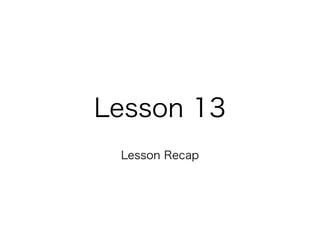
Lesson 13 /Grammar note 3
- 1. Lesson 13 Lesson Recap
- 2. 1. Reviewing the giving and Receiving Japanese people like gifts One thing about Japanese culture is that they're big on giving gifts. There are many different customs involving giving and receiving gifts (お歳暮、お中元、etc.) and when oseibo ochuugen Japanese people go traveling, you can be sure that they're going to be picking up souvenirs to take back as gifts. Even when attending marriages or funerals, people are expected to give a certain amount of money as a gift to help fund the ceremony. You can see why properly learning how to express the giving and receiving of favors and items is a very important and useful skill. For some reason, the proper use of 「あげます」 and 「もらいます」 has always haunted people studying Japanese as agemasu moraimasu being horribly complex and intractable. I hope to prove in this lesson that it s conceptually quite straightforward and simple.
- 3. When to use あげます あげます is the Japanese word for "to give". You must use this verb when agemasu someone (as the giver) is giving something (as the object) to someone (as the receiver). The particle に is used to indicate to whom an object is delivered. Also ni when the subject of a sentence is the giver あげます is used. agemasu person(giver) は person(receiver) に Object を あげます。 wa ni o agemasu * ex. スミスさんは チャンさんに はなを あげました。 sumisu san wa chan-san ni hana o agemashita Mr. Smith gave Ms. Chan some flower. に *The verb あげます conjugates to the past form as あげました. agemasu agemashita
- 4. When to use もらいます moraimasu もらいます is the Japanese word for "to receive". You must use this verb when someone (as the receiver) is receiving something (as the object) from ni someone (as the giver). The particle に is used to indicate from whom ran a s u m o a i m object is delivered. Also when the subject of a sentence is the receiver もらいます is person(receiver) used. は person(giver) に Object を もらいます。 wa ni o moraimasu * ex. チャンさん は スミスさんに はなを もらいました。 chan-san wa sumisu-san ni hana o moraimashita Ms. Chan received some flower from Mr. Smith. に *The verb もらいます conjugates to the past form as もらいました. agemasu agemashita
- 5. Exception case with あげます With あげます, I (the speaker) can NOT be the receiver. There are only 4 cases agemasu as below. ① I give to you (the listener). あ げ ま す ② I give to others. ③ Others ① You ④ ③ You (the listener) give to others. I ② Others ④ Somebody gives to somebody else. person(giver) は わたし(receiver) に Object を あげます。 wa watashi ni o agemasu ex. スミスさんは わたしに はなを あげました。 sumisu san wa watashi ni hana o agemashita (Mr. Smith gave me some flower.) Instead, we use the verb くれます in this exception cases. ex. スミスさんは わたしに はなを くれました。 sumisu san wa watashi ni hana o kuremashita (Mr. Smith gave me some flower.)
- 6. あげます vs. くれます agemasu kuremasu Japanese has two verbs for giving. The choice between the pair depends on the direction of the transaction. Imagine a set of concentric spheres of relative psychological distances, with me at the center, you next to me, and all the others on the edge. When a thing moves away from the center, the transaction is described in terms of the verb あげます. When a thing moves toward the center, the verb we use is くれます. With both あげます and くれます, the giver is the kuremasu agemasu kuremasu subject of the sentence, and is accompanied by the particle は. The recipient is accompanied by the particle に. I give to you (the listener). I give to others. You (the listener) give to others. あ げ ま す Somebody gives to somebody else. I You Others く れ ま す Somebody gives me. You (the listener) give me. People in very close relation such as the speaker s Somebody gives you (the listener). family members are included as I with くれます.
